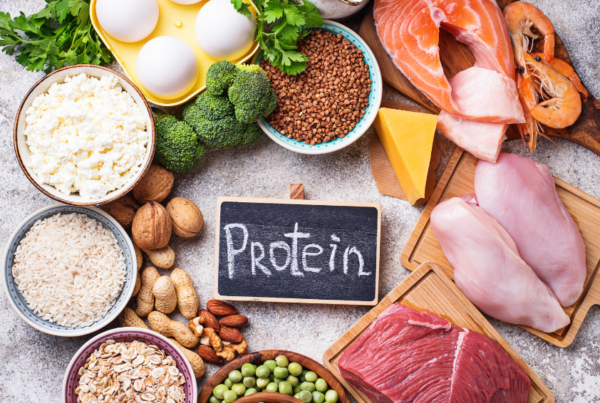When the doctor tells you, that you have osteopenia and you are 0.1 away from osteoporosis, believe me, you want to do something about it. But what? Head down the rabbit hole with Google and you’ll emerge with your head spinning. Research that once said this now says that, but I have tried to unravel from my research what I think is practical, sustainable advice for your overall good health and for good bone health. So here is my advice on how to prevent osteoporosis after menopause.
Research suggests that about half of all women over the age of 60 years will have at least one fracture due to osteoporosis.
Bones and calcium
Bone is living tissue, made mainly from calcium and protein. Healthy bone is always being remodelled; with small amounts being absorbed in the body and small amounts being replaced. Other than for strong bones and teeth, calcium is used for blood clotting, helping muscles to contract, and regulating normal heart rhythms and nerve functions. About 99% of the body’s calcium is stored in bones, and the remaining 1% is found in blood, muscle, and other tissues.
When the body is optimally performing, a steady amount of calcium is maintained in the blood and tissues. When calcium levels drop, the hormone PTH sends a signal to the bones to release calcium. PTH also activates vitamin D to improve the absorption of calcium in the intestines and calls in the kidneys to release less calcium in the urine. When the levels of calcium in the bloodstream are topped up, a different hormone called calcitonin stops the release of calcium from bones and signals the kidneys to remove any excess calcium from the blood out of the body in urine. When it’s all working, it’s super clever.
And then comes menopause
Oestrogen, the sex hormone is essential to female bone health because it promotes the activity of cells called osteoblasts which produce bone. When oestrogen levels drop during menopause, the osteoblasts can’t effectively produce bone. and the body is less able to replace the borrowed calcium from the bones with calcium obtained from food (or supplements). If more bone calcium is absorbed than is replaced, the density or the mass of the bone is reduced. The bone becomes progressively weaker, increasing the risk that it may break.
Osteoporosis is called the silent disease because there are typically no symptoms until a bone is broken or one or more vertebrae fractures.
The reality of this hit home when my friend Trevor and I interviewed Jill Robinson from Animals Asia for our podcast Life in the Last Lane. Jill is an unstoppable woman in her 60’s who, after telling us about her work saving bile bears from China and Vietnam (please check out her website and think about sending a donation) told us she discovered she had osteoporosis after she broke her back. After excruciating surgery and many months in bed, she is now on a mission to encourage women post-menopause to have their bone density checked and do something about strengthening their bones before it’s too late.
Start with DEXA scan –most of it is covered by Medicare.
Medicare will cover a bone density test (DEXA Scan) every 24 months, or more often if medically necessary if your doctor thinks you are estrogen-deficient and at risk for osteoporosis.
ACTION: Have the scan, know your numbers, and understand what you are dealing with. It’s better to discover you have osteoporosis and get treatment for it than discover you have it after fracturing your back.
CUT BACK ON SUGAR, and DIET SOFT DRINKS
I tell everyone to do this anyway but here’s yet another reason why. New research suggests that sugar presents a greater risk than salt on bone health and excess sugar leads to:
• Mineral loss of calcium and magnesium through urine.
• Reduced intestinal absorption of calcium by lowering the levels of active vitamin D
• Impaired bone formation
Diet cola specifically appears to have the greatest impact on bone health. Women who drink 3 or more glasses of cola a day were found to have almost 4 % lower bone mineral density in the hips than those who don’t.
ACTION: Aim to cut sugar from your everyday diet and enjoy it occasionally. A dessert on the weekend for example. Cut out soft drinks completely, including diet soft drinks, and especially diet colas.
CUT BACK ON SALT FROM PACKAGED FOODS
I tell everyone to do this too! Although the focus appears to have shifted from salt to sugar, scientists unanimously agree that reducing your intake of highly processed packaged foods is solid health advice. Earlier studies show that excess salt leads to;
• Loss of calcium in the urine.
• High blood pressure from a high salt diet increases the rate calcium is lost from the bones.
ACTION: Reduce your intake of packaged salty foods and use salt to flavour fresh natural home-cooked meals.
CUT BACK ON ALCOHOL
I covered alcohol in the recent blog How much alcohol is considered safe to drink post-menopause. Some studies suggest a small amount of red wine may help maintain strong bones, but excessive alcohol consumption can:
• Reduce intestinal absorption of calcium.
• Adversely impact vitamin D metabolism in the pancreas. Vitamin D is needed to help the body absorb calcium.
ACTION: Limit your alcohol consumption to less than 7 standard alcoholic drinks a week. A standard drink is 100 ml wine. Red wine is better.
INCREASE DIETARY CALCIUM
Calcium is a large mineral and is not easily absorbed. The amount that is absorbed and used by the body is called calcium bioavailability and some foods have higher calcium bioavailability than others.
Dairy Foods are, hands down, the most calcium-rich foods you can eat, however, many people can’t tolerate dairy or don’t like it. The easiest way to reach 1,300 mg calcium (the RDI for women and men over 51) would be to drink a litre of whole or reduced-fat milk each day, however, if you are trying to watch your weight and reduce energy from food, you may get the calcium you need but it will be at the expense of a lot of extra calories and a limited number of beneficial nutrients you would otherwise get from a wider range of nutrient-dense foods.
I would also caution anyone who currently doesn’t drink milk from taking to the (milk) bottle. If there is an underlying inflammatory gut issue it may be exacerbated with the extra dairy. Natural yoghurt, and kefir are both good sources of dairy with the added benefit of probiotics to help improve digestion.
Plant foods are the alternative for those who won’t or can’t eat dairy and certain plant foods supply calcium in lesser amounts. Bok choy contains about 160 mg of calcium per 1 cup cooked but has a higher bioavailability of 50%, so about 80 mg is absorbed. Therefore, eating 1 cup of cooked bok choy has almost as much bioavailable calcium as 1 cup of milk.
Calcium-Rich Foods
• Dairy (cow, goat, sheep) and fortified plant-based milk (almond, soy, rice)
• Cheese
• Yogurt
• Calcium-fortified orange juice
• Pumpkin
• Edamame (young green soybeans);
• Tofu, made with calcium sulphate
• Canned sardines, salmon (with bones)
• Almonds
• Sesame seeds
• Leafy greens (silverbeet, kale, bok choy, spinach)
For a comprehensive list of calcium-rich foods visit www.healthybonesaustralia.org.au
ACTION: Increase your intake of calcium-rich foods
Calcium-binding foods.
Remember Pete Evans and his activated almonds? As much as it pains me to write this, Pete did have a point because nuts and seeds contain phytic acid which has, rather unfairly, earned the term antinutrients because they bind onto calcium and decrease its bioavailability. Oxalic acid is another calcium-binding agent naturally found in many otherwise extremely healthy plant foods. I say unfairly because despite these “antinutrients” they make up some of the most nutrient-dense foods we can eat and, because there are ways around this, please don’t demonise them. Spinach, silverbeet, sweet potatoes, rhubarb, legumes, nuts, seeds, and whole grains can inhibit calcium absorption to a varying extent but there are ways to overcome the problem.
ACTION:
- Reduce phytates and oxalates in foods by blanching green leafy vegetables, and soaking whole grains nuts and seeds. Choose Asian greens over spinach and silverbeet.
- Avoid eating calcium-rich foods together with calcium-binding foods. For example, drink a green smoothie made with spinach and leave some time to digest before drinking a coffee with milk or fruit with yoghurt.
SUPPLEMENTS – VITAMIN D3, AND VITAMIN K2, MAGNESIUM, CALCIUM,
Please NOTE: The information below is nonprescriptive. Recommended intake is not provided. It is no substitute for the advice and treatment of a professional practitioner.
From everything I have read, this is what I have chosen to take.
- Combined K2 and D3
- Magnesium
- Powdered Green Calcium
Combined K2 and D3
According to a study published in 2017 Vitamin K2 appears to improve bone quality, which leads to a reduction in fractures. The lifetime risk of having at least one fracture is reduced by 25% with the daily use of 800 IU vitamin D, 45 μgm vitamin K2, and 1,200 mg calcium. There is some evidence to suggest that taking K2 and D3 together has synergistic benefits.
MAGNESIUM
People with higher intakes of magnesium have a higher bone mineral density, which is important in reducing the risk of bone fractures and osteoporosis. I take magnesium glycinate which has been shown to have a variety of added benefits, including, relieving anxiety, amplifying exercise performance, pain relief, managing blood sugar levels, and maintaining normal heart rhythms. Current research shows that additional magnesium can help the body relax and even improve symptoms of insomnia.
CALCIUM
For years we have been told to supplement with calcium and the most common calcium supplements are calcium carbonate and calcium citrate. HOWEVER – Excessive calcium intake from supplementation carries health risks including kidney stones, constipation, and, a growing body of research suggests, heart disease. It can also block the absorption of other important minerals like zinc and iron. Calcium carbonate contains more calcium, but it must be taken with food and it’s not easy to digest if you have low stomach acid. Calcium Citrate is a bulkier form of calcium that can be taken without food. Despite having less calcium, the calcium is more bioavailable with calcium citrate, and it can be taken without food. It’s extremely important to note that a supplement must supplement the diet and not be the foundation of your calcium intake. If you do decide to supplement with calcium take no more than 2,000 mg a day.
Green Calcium
After extensive research, I decided to take ½ tsp Green Calcium twice a day with food. Green Calcium is made from a natural mineral source produced from calcareous marine algae (Lithothamnion sp.). The seaweed is harvested from the North Atlantic seabed. An, albeit small, trial found this natural mineral source produced from calcareous marine algae (Lithothamnion sp.). has a significantly higher bioavailability to calcium carbonate.
ACTION: Get your diet right first and then, as I did, if you think that you can’t meet the recommended daily intake of calcium OR get sufficient sunlight to make Vitamin D which helps calcium absorption you may consider supplementation.
Weight-bearing exercise.
No, I haven’t forgotten this and if you have completed the Lighten Up Course you will know that I do encourage you all to complete at least 3 x 25-minute sessions of weight-bearing exercise a week.
ACTION: Use weights, stretch bands, balancing exercises, and walk regularly to keep this up.
And finally – most controversially there’s HRT.
This is one for you, your doctor, and your endocrinologist. Doctors are not licensed to prescribe HRT for bone health however it has been shown to reduce the risk of fracture and can be used to prevent or treat osteoporosis in women. It is considered to be a safe and effective treatment with many additional benefits other than to the skeleton.
ACTION: Speak to your doctor, do your own research, and if you think this is the course of action you would like to consider, get a referral to an endocrinologist.





Recent Comments